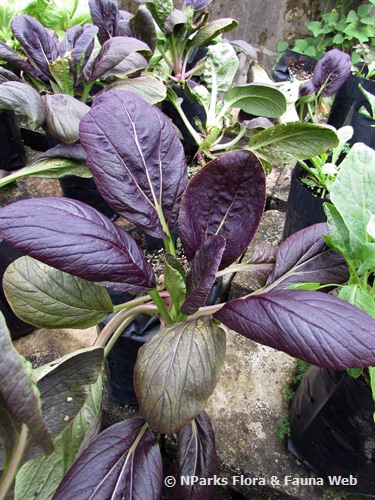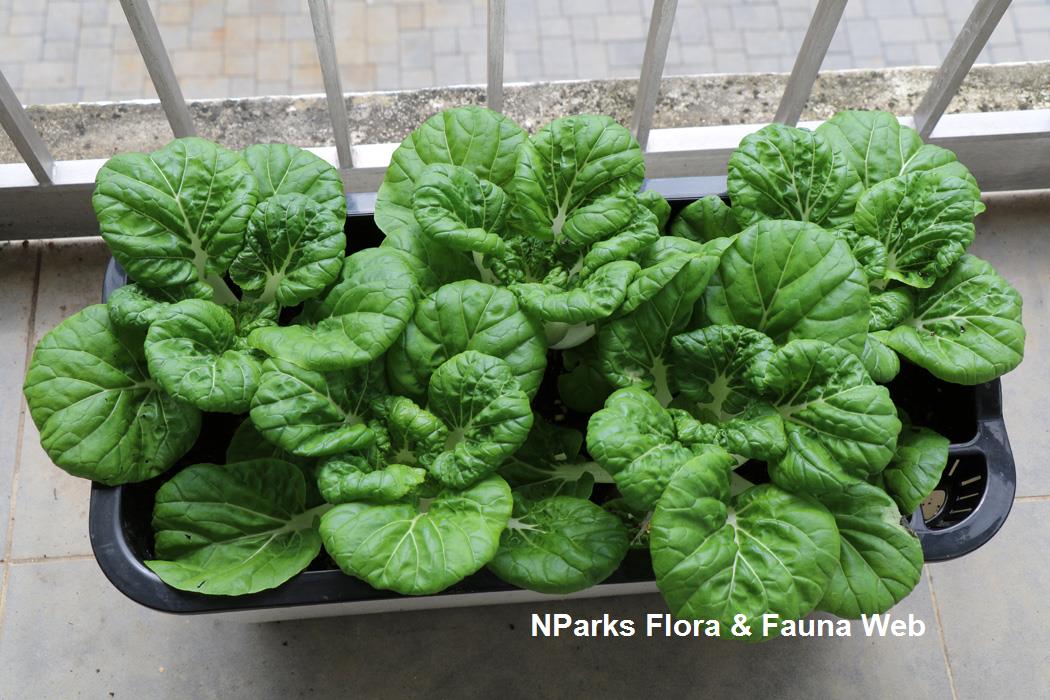![Brassica rap Pak Choi Group [Purple Pak Choy]](/-/media/ffw/protected/flora/7/2/7263/brassica-rapa-(purple-pak-choy)_jacqueline-chua-(1).jpg)
Name
Classifications and Characteristics
| Plant Growth Form | Herbaceous Plant |
|---|---|
| Lifespan (in Singapore) | Annual |
| Mode of Nutrition | Autotrophic |
| Maximum Height | 15 cm to 20 cm |
Description and Ethnobotany
| Foliage | Dark purple, oval leaves with long, greenish cream-coloured petioles are arranged in a loose rosette. The venation is palmate. |
|---|---|
| Cultivation | Seeds may take 3 to 5 days to germinate. Does well in full sun but also tolerant of partial shade. Prefers to grow in fertile and well-drained soil. Depending on the varieties, the plant may take 30 to 35 days to reach a suitable harvest size. Once the plants reach 20 cm tall or the desired size, they are ready for harvesting. |
| Ethnobotanical Uses | Edible Plant Parts : Edible Leaves Food (Fruit or Vegetable): The leaves turn bright green when cooked, but you can also eat them raw if you want to maintain the purple colour. The baby leaves are better for salads. |
Landscaping Features
| Thematic Landscaping | Economic Garden |
|---|
Plant Care and Propagation
| Light Preference | Full Sun |
|---|---|
| Water Preference | Moderate Water |
| Rootzone Tolerance | Moist Soils, Well-Drained Soils, Fertile Loamy Soils |
Foliar
| Mature Foliage Colour(s) | Purple |
|---|---|
| Mature Foliage Texture(s) | Smooth |
| Foliar Type | Simple / Unifoliate |
| Foliar Arrangement Along Stem | Rosulate / Rosette |
| Foliar Attachment to Stem | Petiolate |
| Foliar Shape(s) | Non-Palm Foliage |
| Foliar Apex - Tip | Rounded |
| Foliar Base | Cuneate |
Floral (Angiosperm)
| Flower & Plant Sexuality | Bisexual Flowers |
| Flower Colour(s) | Yellow / Golden |
|---|---|
| Flower Texture(s) | Smooth |
| Flower Grouping | Cluster / Inflorescence |
| Flower Location | Terminal |
| Flower Symmetry | Radial |
| Individual Flower Shape | Cruciform / Cross-shaped |
Image Repository
Others
| Master ID | 32849 |
|---|---|
| Species ID | 7263 |
| Flora Disclaimer | The information in this website has been compiled from reliable sources, such as reference works on medicinal plants. It is not a substitute for medical advice or treatment and NParks does not purport to provide any medical advice. Readers should always consult his/her physician before using or consuming a plant for medicinal purposes. |








